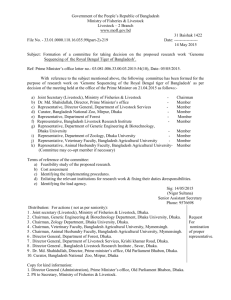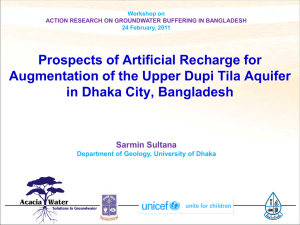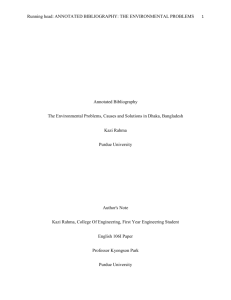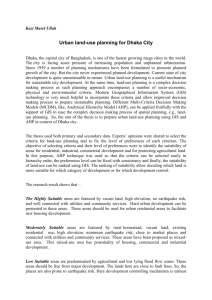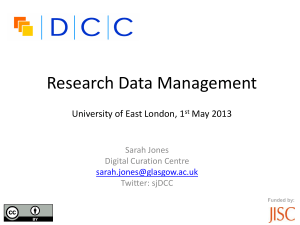Introduction of Municipality - Kitakyushu Initiative for a Clean
advertisement
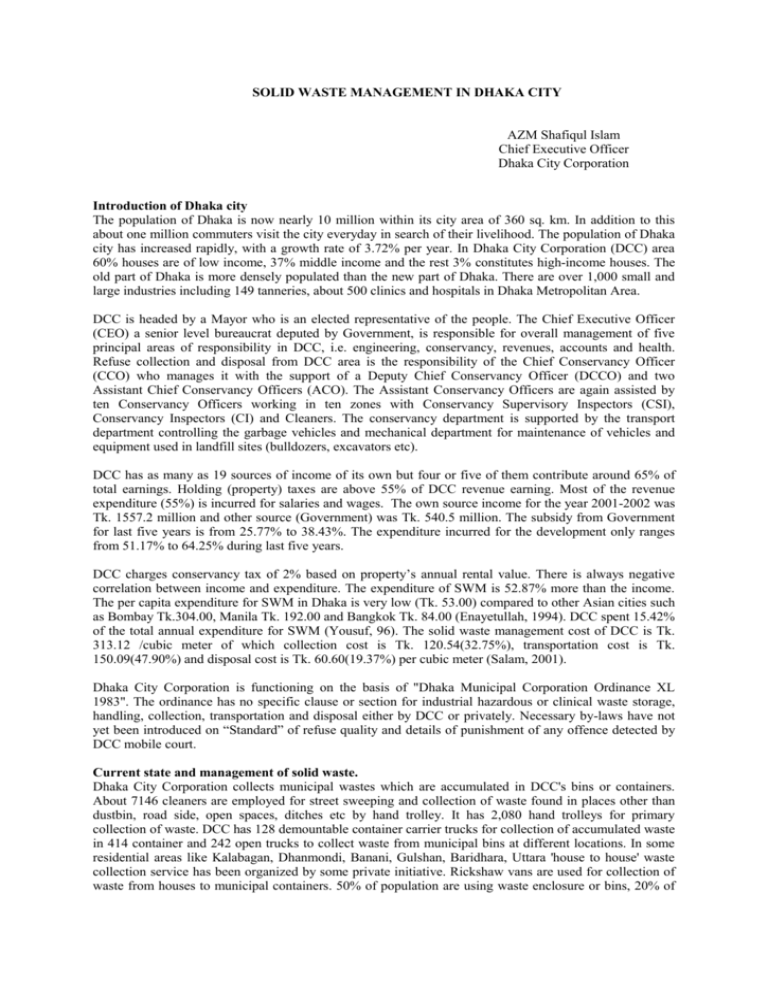
SOLID WASTE MANAGEMENT IN DHAKA CITY AZM Shafiqul Islam Chief Executive Officer Dhaka City Corporation Introduction of Dhaka city The population of Dhaka is now nearly 10 million within its city area of 360 sq. km. In addition to this about one million commuters visit the city everyday in search of their livelihood. The population of Dhaka city has increased rapidly, with a growth rate of 3.72% per year. In Dhaka City Corporation (DCC) area 60% houses are of low income, 37% middle income and the rest 3% constitutes high-income houses. The old part of Dhaka is more densely populated than the new part of Dhaka. There are over 1,000 small and large industries including 149 tanneries, about 500 clinics and hospitals in Dhaka Metropolitan Area. DCC is headed by a Mayor who is an elected representative of the people. The Chief Executive Officer (CEO) a senior level bureaucrat deputed by Government, is responsible for overall management of five principal areas of responsibility in DCC, i.e. engineering, conservancy, revenues, accounts and health. Refuse collection and disposal from DCC area is the responsibility of the Chief Conservancy Officer (CCO) who manages it with the support of a Deputy Chief Conservancy Officer (DCCO) and two Assistant Chief Conservancy Officers (ACO). The Assistant Conservancy Officers are again assisted by ten Conservancy Officers working in ten zones with Conservancy Supervisory Inspectors (CSI), Conservancy Inspectors (CI) and Cleaners. The conservancy department is supported by the transport department controlling the garbage vehicles and mechanical department for maintenance of vehicles and equipment used in landfill sites (bulldozers, excavators etc). DCC has as many as 19 sources of income of its own but four or five of them contribute around 65% of total earnings. Holding (property) taxes are above 55% of DCC revenue earning. Most of the revenue expenditure (55%) is incurred for salaries and wages. The own source income for the year 2001-2002 was Tk. 1557.2 million and other source (Government) was Tk. 540.5 million. The subsidy from Government for last five years is from 25.77% to 38.43%. The expenditure incurred for the development only ranges from 51.17% to 64.25% during last five years. DCC charges conservancy tax of 2% based on property’s annual rental value. There is always negative correlation between income and expenditure. The expenditure of SWM is 52.87% more than the income. The per capita expenditure for SWM in Dhaka is very low (Tk. 53.00) compared to other Asian cities such as Bombay Tk.304.00, Manila Tk. 192.00 and Bangkok Tk. 84.00 (Enayetullah, 1994). DCC spent 15.42% of the total annual expenditure for SWM (Yousuf, 96). The solid waste management cost of DCC is Tk. 313.12 /cubic meter of which collection cost is Tk. 120.54(32.75%), transportation cost is Tk. 150.09(47.90%) and disposal cost is Tk. 60.60(19.37%) per cubic meter (Salam, 2001). Dhaka City Corporation is functioning on the basis of "Dhaka Municipal Corporation Ordinance XL 1983". The ordinance has no specific clause or section for industrial hazardous or clinical waste storage, handling, collection, transportation and disposal either by DCC or privately. Necessary by-laws have not yet been introduced on “Standard” of refuse quality and details of punishment of any offence detected by DCC mobile court. Current state and management of solid waste. Dhaka City Corporation collects municipal wastes which are accumulated in DCC's bins or containers. About 7146 cleaners are employed for street sweeping and collection of waste found in places other than dustbin, road side, open spaces, ditches etc by hand trolley. It has 2,080 hand trolleys for primary collection of waste. DCC has 128 demountable container carrier trucks for collection of accumulated waste in 414 container and 242 open trucks to collect waste from municipal bins at different locations. In some residential areas like Kalabagan, Dhanmondi, Banani, Gulshan, Baridhara, Uttara 'house to house' waste collection service has been organized by some private initiative. Rickshaw vans are used for collection of waste from houses to municipal containers. 50% of population are using waste enclosure or bins, 20% of population using roads to dispose of waste, 20% of population using drains to dispose of waste and 10% of population using open ground to dispose of waste (MMI, 1992). The total amount of solid waste generated everyday in DCC area is about 4500 to 5000 tons. According to Mott Macdonald International Ltd report of 1991, waste stream fraction of Dhaka city is 46.8% domestic, 21.8% street sweeping, 19.2% commercial, 12.9% industrial and 0.5% clinical. Solid waste flow of a residential area is 58.7% domestic, 33.08% street sweeping, 7.9% commercial and 0.32% clinical (Salam, 2001). Analysis of physical composition of domestic waste show that the primary component is food waste covering 72.50%, polythene 13.70% (production banned by now), paper and cardboard 5.63%, and plastic 3.31%. There is a variation of waste composition between down town and residential area of new parts of Dhaka. Domestic waste generation rate for residential area is 0.60 kg per person a day (Salam, 2001) At present DCC has no waste treatment and recycling plant. Informal sector exists in resource recovery and recycling of solid waste in Dhaka City. The poor and socially disadvantaged people working in the street, waste bins, dumpsite totaling more than 87000 people are involved in the recycling activities. This informal sector is absorbing almost 10% of total employed work force. And the sector is responsible for removing 26% of total generated waste of DCC area (Sinha 1993). Success, Issues and Future Direction: Waste Concern: An NGO Initiative: Due to increasing unemployment and lack of job opportunities, a large group of urban poor of Dhaka City are gradually getting involved in the recovery process of inorganic recyclable materials from waste with economic value for their survival. It is estimated by a study that 55% of Dhaka population lives below the poverty line. Although this poor labor force plays an important role in reducing waste (15% of the total solid waste generated) to be managed by Dhaka City Corporation their contribution remains largely unrecognized. Ironically a large portion of organic matter (almost 80% of the waste) with the potentials of converting it into economic resource (compost / organic fertilizer) remains totally unutilized collected by these poor people. In 1995, a local NGO called Waste Concern initiated a small-scale, community-based organic waste recycling project for composting the municipal solid waste. Waste Concern’s initiative had three aims: i) Capture value from the organic portion of Dhaka’s solid waste, ii) Create job opportunities for the urban poor and iii) Create business opportunities for local entrepreneurs. In January 1996 a local Lions Club (Dhaka North) donated a small piece of vacant land (1000 square meters) for the composting project. Waste concern’s composting plant is the first of its kind in Bangladesh. The primary goal is to explore the technical and commercial feasibility of labor-intensive aerobic composting. The technique is based on waste reduction and separation of compostables, recyclables, and other wastes. Source-separated organic wastes are collected from the neighboring community, vegetable markets and local hotels. At present, one project manager and six persons (three female and three male), from informal labor are working in the project. About 200 kgs of compost is produced from one truck of collected solid wastes. Three hundred households in Mirpur have been included under the composting project. Modified Rickshaws-vans are used by Waste Concern for the house-to-house collection system. A fee of Tk. 10 / month is charged to each household. The collected domestic waste is separated and sorted in the composting planting site and processed into compost. After continuous demonstration of the project to the stakeholders of Bangladesh in 1998 under the Sustainable Environmental Management Program (SEMP) the Ministry of Environment and Forest with the support from UNDP requested Waste Concern to replicate the model in 5 different communities of Dhaka City. Land was the biggest constraint to initiate the model of community based composting plants in the city. Later on, after continuous advocacy and demonstration, the Dhaka City Corporation and Public Works Department were convinced and came into a partnership with Waste Concern by providing land for the composting plants. Realization of full potential of this kind of project, however, can only be achieved if the government or municipal authorities provide the following types of support: - Land should be provided free of cost or at a nominal rate to the entrepreneurs interested to run the project. Waste concern’s experience shows that the enrichment of compost with necessary nutrients can make it more attractive, affordable and effective to the farmers. Parichchanna Kalabagan According to the need of the community, DCC could not place waste bins in Kalabagan, a densely populated area of Dhaka City due to its narrow lanes and by-lanes. The environment had deteriorated due to the emissions of bad smells from indiscriminate littering of decomposed wastes and also from clogged drain waste. This unbearable situation drew the attention of one resident of the area Mr. Khurram who with his friend devised a mechanism to tackle the situation. In 1987, he purchased two old rickshaws and turned them into carriers. With the local community participation attitude these vans began collecting waste from house to house and disposing them at community bins. The van rickshaws were fitted with honk and each van rickshaw was manned by 3 persons. The success of this operation has led to the formation of numbers of CBOs at different parts of Dhaka city. The experience of the Kalabagan CBO approach reveals that a house to house collection of domestic waste is very effective from the viewpoints of cost and environment (Mohit, 1995) Dhanmondi solid waste management: From January 01, 2002 Sheltech Consultants (Pvt) Ltd. has started a pilot project to manage the solid waste related problems of Dhanmondi in a precise way along with assistance of Dhaka City Corporation. The main objective of the project are to relieve residents of the area from hazard of unmanaged garbage bins to provide door to door garbage collection by specially designed conservancy vans and disposal in municipal garbage containers & drain and street cleaning. For operating the pilot project the total Dhanmondi R/A has been divided into 9 blocks. 300 households of Blocks-G & H had been taken under the initial operations. Before intervention, the main identified problems of solid waste and disposal were a) Lack of awareness of waste disposal and environmental sanitation at household level, b) No awareness creation at community level, c) Roadside bins are insufficient and often broken, d) Scattering of waste from bins by animals and scavengers and e) throwing of waste into drains which causes blockages and overflow into streets. Sheltech Consultants Pvt. Ltd (SCPL) has provided 2 garbage containers (Blue & Red) to every household for disposal of garbage separately, where blue and red container receives inorganic and organic waste accordingly. Between 1am to 4 pm of the day the conservancy workers (Shebak) visit those households with their special designed vans to collect waste. This collected waste is disposed of at the central dumping sites of each block, where containers are kept under strong observation and monitoring of SCPL workers, so that the scavengers cannot scatter the garbage while collecting inorganic materials from the dumping sites. Subsequently the collected wastes are taken away by DCC transport to the central dumping sites on time (between 4pm – 6pm). SCPL collects revenue from every household at the end of the month and spend it for workers salary. The major impacts of the project for last 9 months are as follows: Environmental pollution such as air, water and soil pollution has significantly reduced in the area. The project members (H.H) do not use the existing dust bins for disposing their daily wastes any more which help reduce air pollution and scatter wastes in the neighborhood. As the wastes (Organic & Inorganic) are separated in the houses and disposed in different containers it became easier for the project authority to sell the inorganic materials to the retailers and re-cycle company. On the other hand only the organic wastes are disposed in the secondary dumping sites, which is eventually carried away by DCC transport. Secondary dumping sites are monitored by the project monitors which help reduce scattering waste out side the bins and adjacent road. The project has helped to generate positive behavioral changes of the community. Major obstacles of the project: The project authority could not expand the project satisfactorily due to lack of public awareness and motivation. No massive awareness-building programme has been launched in the area by SCPL or DCC. Many households have refused to take the service, as they believe DCC should carry out such activities as they realise taxes from the dwellers. The hospital wastes are still disposed to the dustbins which lessen the project achievement and degrading Dhanmondi`s environment. DCC conservancy trucks do not show up on time which also creates problem for the project authority. Existing Problems The main problems and limitation of present solid waste management system of DCC are Lack of institutional arrangement: Conservancy department of Dhaka City Corporation has no scientific and engineering principle based on solid waste management planning approach. Conservancy department has no solid waste management specialist (Engineering background). Present distribution of labor, transport in different areas has no database demand and conservancy department does not maintain any data base for generation of waste, transport and labor requirement. There is no cleanliness standard. Town planning department is yet to allocate any space for storage of waste bin, placing of container. Placing of dustbin on the road, near any house creates social problem because of improper use, irregular cleaning and road blockage by collection vehicle, bad smell, rodent, vermin’s, flies and unhygienic condition. At present transport fleet of City Corporation is collecting 43% waste by open truck (DCC). Open truck collection system needs average 3-5 hr for loading and unloading the waste to and from the trucks. So disposal by open truck yield very low efficiency. Insufficient financial resources: DCC normally spends14-17 percent of its budget on SWM. Municipalities in the developing countries spend 20 to 40 percent of municipal revenues (UNCHS, 1998) Inefficient management of existing manpower, equipment other resources, unscientific and inefficient collection practices, inefficient management of landfill, Absence of by-laws and standards. Recommendations To overcome existing problems Kitakyushu Initiative can provide the following assistance and cooperation to the Dhaka City: Institutional strengthening Capacity building: Training to the Conservancy department personnel to manage scientifically the solid waste management issues. a) Gradual privatize solid waste management (collection, transportation and disposal) b) Landfill design and management c) Formulate the policy for community-based program, local initiative, NGO- small enterprise initiative. e) Waste reduction and recycling project. f) Preparation of legislation, (by laws, rules, regulations) Exchange of information Public awareness program Assistance for sustainable solid waste management through generation of electricity, gas, fertilizer, ceramic product etc. Conclusions The success of a community-based program depends largely on identifying and addressing the community’s needs while sustainability of the project depends on involving them in the cost-recovery/costsharing process. Community based projects have demonstration effect. NGOs can play an important role in initiating, demonstrating new concepts, providing technical know-how and providing training to others. Small-scale compost plant can be located within the community provided appropriate scientific composting method is followed. Decentralized compost plant is commercially viable as seen from the Mirpur experience. It has been found that women from informal sector are interested to work in the composting plant which is socially acceptable. Initially, marketing of compost was a major problem. This problem was solved involving the private specialized fertilizer marketing companies (experienced and already having extensive network all over Bangladesh). Press has played a positive role in disseminating the project activity in Bangladesh. Apart from media, Government has to make necessary policy conducive to marketing of compost. Based on the evidence gathered so far by the pilot project of Waste Concern, it appears that this type of micro-enterprise can be replicated elsewhere in Bangladesh as well as in other Asian Countries. During implementation of Dhanmondhi project it has been found by SCPL that a large number of residences are not aware of health hazard and solid waste related problems. Many households are not taking the project service rather dispose of garbage in near by open spaces. Therefore, it is important to launch a long-term awareness building and campaigning programme in the area so that people get motivated about enhancing own environmental conditions and participate in the pilot project willingly. Awareness building programme can be launched in other areas of the city to motivate people about cleanliness and personal hygiene. Recently in May, 02 DCC selected other 7 Wards of the City to carry out similar kind of solid waste management project like Dhanmondi area involving CBOs and local NGOs to which Kitakyshu has agreed to extend its cooperation. Kitakyshu Initiative could cooperate in providing technical know-how for setting modified transfer station, financial support for public awareness and also motivation programme for the project. REFERENCES Salam, M.A (2001); ‘Analysis and Design of Solid Waste Management System for A Residential Zone of Dhaka City’ M.Sc. Engineering Thesis, Department of Civil Engineering, Bangladesh University of Engineering and Technology. Dhaka. Enayetullah, (1994); 'A Study of Solid Waste Management for Environmental Improvement of Dhaka City' Master thesis Department of URP, Bangladesh University of Engineering and Technology. Dhaka. Mohit, M.A. (1995); Solid Waste Management in Dhaka City': A case of Neighborhood involvement collection system' Paper presented in a workshop in World Habitat Day, Dhaka, October 2. MMI (1990): 'Solid Waste Management Draft Technical Manual' Prepared by Mott. Macdonald Limited International, in association with Cuplin planning limited, Engineering and Planning consultants limited. DMDP (1992); 'Dhaka Metropolitan Development Planning Waste Management Report' Prepared by Mott. Macdonald Internal Limited. Engineering and Planning consultant GOB, RAJUK. Sinha, Maqsood, A.H.M (1995) 'Solid Waste Management and Recylcing in Dhaka': Problem and prospects a paper published in 'EARTH Magazine' issues No. 4, 1995 Sinha, Maqsood, A.H.M (1995) 'Recycling Potentials of Organic Waste in Dhaka' a paper published in 'EARTH Magazine' Issue No. 5, 1995.

